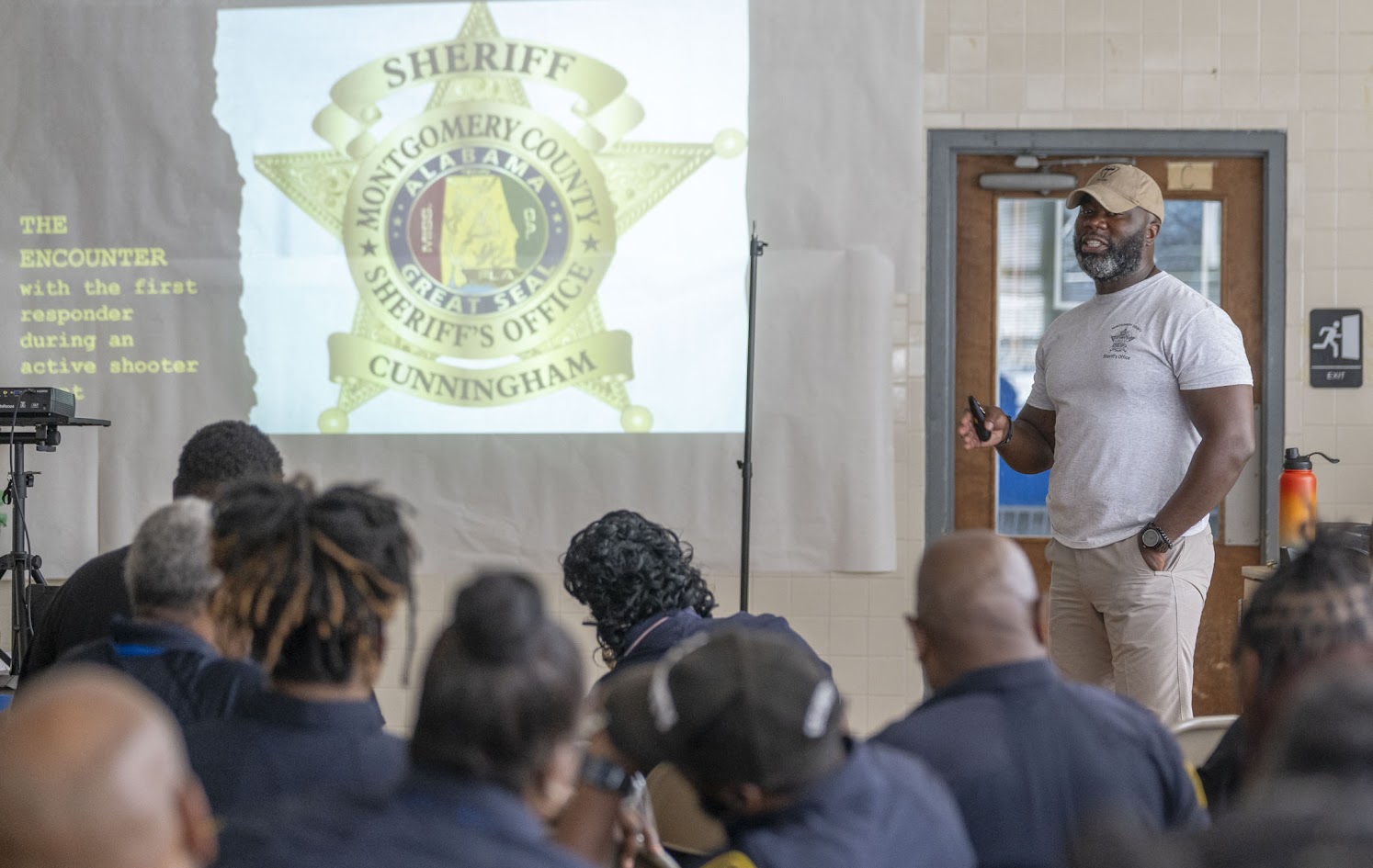
By Hazel Scott/ASU
Alabama State University remains committed to supporting initiatives that provide for campus and community safety. With the reality of mass shootings in places of worship, classrooms and other public settings, many people may fear for their own safety and the safety of their loved ones.
To help alleviate some of these fears for parents, ASU’s Preventing School Violence (PSV) program sponsored a three-day Critical Incident Response Training session for Montgomery Public Schools (MPS) in collaboration with other regional partners, including CrimeStoppers. The event culminated at MPS’ Dunbar-Ramer School with an active shooter exercise by the Montgomery County Sheriff’s Office.
"Alabama State University gave us the ability to train our active shooter response facilitators with sound tactics and other skills," said Lt. Jessie Oliver from the Montgomery County Sheriff's Department.
The program is designed to equip law enforcement officers, school security personnel, and administrative staff with advanced strategies for managing crises, active shooter situations, threat assessments, and school-based policing.
"Alabama State University wants to utilize our resources to ensure that not just the ASU community but the community as a whole is safe and secure," said Avionne Ruffin, PSV director.
Key focuses include identifying school threats, enhancing emergency operations planning, and clarifying law enforcement roles during critical incidents.
"This is giving our officers the skills they need to protect our students, faculty and staff and keep them safe," added ASU alumni, Dr. Johnny Cotton, Safety and Security Advisor for Montgomery Public Schools.
BE PREPARED
ASU spoke with experts at the event to learn what they want everyone to know about potential or active shooter situations, including steps to take when situations appear to be suspicious and other useful protection measures.
1. Trust Your Instincts and Stay Alert
Experts say sometimes the most obvious points are the most crucial. They advise people to down their phones and tune in to their surroundings.
“Don’t tune out in public spaces—notice who’s in the area, what is 'normal,' and changes in behavior, mood, or environment. Take mental notes of entry and exit points,” said Tony A. Garrett, CrimeStoppers director.
Also key is recognizing warning signs, including expressing violent intentions, making threats, behaving erratically, or showing fascination with weapons or past shootings.
“In an active shooting situation, follow alerts and pay attention to official messages from authorities, schools, or alert systems and respond accordingly,” said Garrett.
2. Make a Mental ‘What If’ Plan
Authorities say people must have the mindset that when they are in public spaces, something bad can potentially happen; so they must prepare themselves with the “what if” scenario mentally.
If used correctly, that strategy could potentially save somebody’s life.
“Visualize your options. Mentally rehearse what you would do if you heard shots or alarms: Where would you run, hide, or shelter? What exits are nearby? What could you use for blocking a door or protection?” said Garrett.
Garrett recommends practicing regularly. “Think through scenarios with family, friends, and coworkers in your most frequently visited places.”
3. Know What to Look For
Garrett said people should not ignore their concerns regarding suspicious activity. If one sees, hears, or senses something unusual, report it to the authorities, school staff, campus police, or organizations like CrimeStoppers by calling or texting 215-STOP for anonymous tips.
“Details matter. Provide descriptions, locations, behaviors, and any direct quotes or evidence to responders for rapid assessment,” noted Garrett.
4. Follow ‘Run, Hide, Fight’ or ALICE Principles
In an active shooter situation, Garrett emphasized that individuals must quickly decide how to respond. Two well-known protocols provide guidance: Run, Hide, Fight and ALICE (Alert, Lockdown, Inform, Counter, Evacuate).
- Run: If you can safely leave the area, do so immediately — encourage others to also leave the area.
- Hide: If escape is not possible, barricade yourself and others in a secure room. Silence electronics, lock or block doors, and remain as quiet as possible.
- Fight: As an absolute last option, and only when your life is in imminent danger, act decisively to disrupt or incapacitate the attacker using anything available — throw objects, yell, and commit wholeheartedly to your actions.
- ALICE: Know that these options are not sequential but can be applied as the situation changes.
5. Practice Communication and Community Engagement
Authorities explained that effective communication and community engagement are paramount in mitigating the impact of active shooter situations and fostering a sense of preparedness and resilience within the community.
“Talk regularly with peers, teachers, or children about concerns, safety, and what they’re seeing or hearing at school. Role model non-violent conflict resolution by displaying peaceful solutions in your disputes and supporting a culture of reporting and respect,” said Garrett.
Participating in drills and programs is an important step. Garrett recommended attending safety briefings, participating in lockdown and evacuation drills, and knowing school or workplace policies.
6. Know What to Do When Law Enforcement Arrives
In an active shooter situation, Garrett said the arrival of law enforcement marks a critical phase, and your reactions can be crucial to your safety and the success of their intervention.
Here’s what to do:
- Remain calm and comply: Keep your hands visible, drop any items, and follow instructions without sudden movements.
- Give clear information: If possible, identify yourself, the location of the shooter, the number of shooters, and any victims or hazards.
7. After the Event
It is crucial to cooperate with authorities, to remain at assembly points, and not to leave until released.
“Support each other by providing emotional support for those affected and accessing counseling if needed,” Garrett noted.